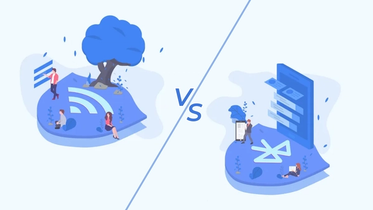How to Make a Loyalty App
Published: May 2, 2022
17 min read
In this article, you'll learn:
1
🚀 How a Mobile App can Boost Your Loyalty Program
2
🎁 Rewards & Loyalty Strategies
3
📊 The Admin Panel for Loyalty Apps & Strategies
4
🤖 The Tech Stack for Loyalty App Development
5
💰 What Affects Loyalty App Development Costs
6
💡 Takeaways
In the era of capitalism, the competition spins up every other week. Thus, many businesses face the problem of attracting new customers and turning them into loyal ones.
Did you know that almost 62% of consumers are loyal to 1-5 brands only? If we take a look at what makes customers loyal to a certain brand, the opportunity to join a loyalty program takes 4th place after the product/service itself, price, and customer service.
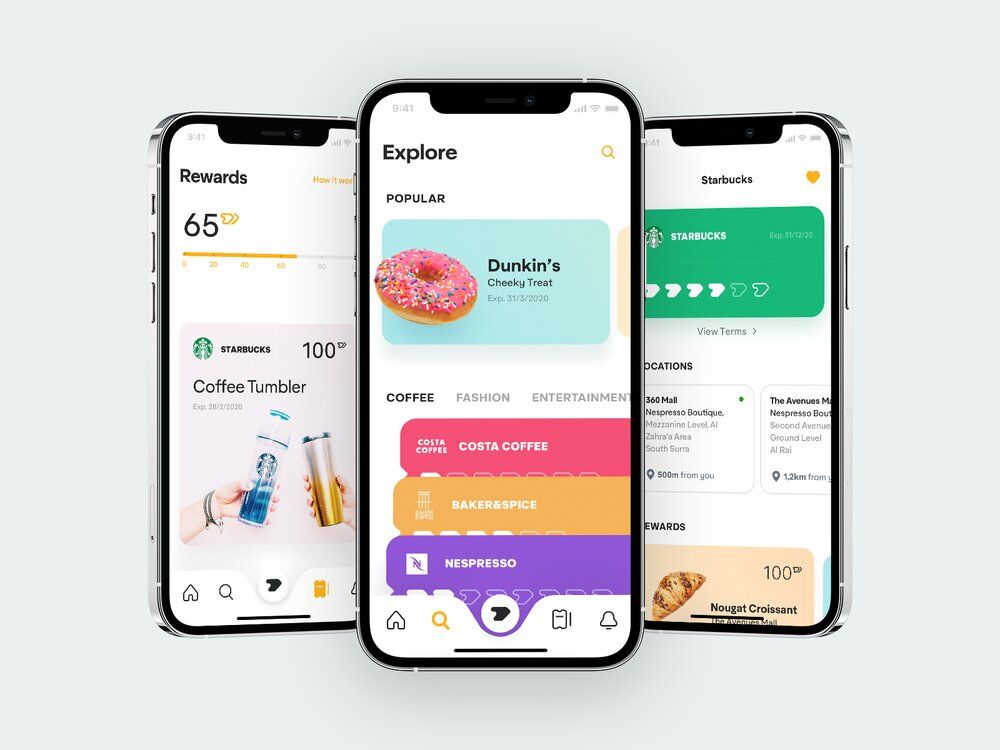
It might be a good idea to develop a loyalty app for your rewards program since it helps brands build digital loyalty (image by Adrian Reznicek)
Surely, there are a bunch of ways how businesses can deliver their loyalty programs to consumers. However, with mobile devices dominating the market & bringing the most traffic, many companies opt for an app. Additionally, 66% of businesses that experienced a lowering of customer loyalty don’t have a mobile app for their programs.
In fact, more than 70% of customers are more likely to take part in a loyalty program if it’s easy for them to access rewards & loyalty cards on their mobile devices.
So, if you want to build an app for your business or get to know how to improve an existing solution with loyalty features — keep on reading!
🚀 How a Mobile App can Boost Your Loyalty Program
Having a well-thought-out loyalty program itself can be highly beneficial for your business. However, with an app, you can boost these benefits, as well as deliver additional value for your clients by improving customer experience.
Retention Rate & Engagement 🔄
Increasing the retention rate by 5% can boost your sales up to 95%, which sounds like quite a deal. Since loyalty features are one of the greatest ways to improve this metric, an app can help you go for an even higher retention rate than you have now.
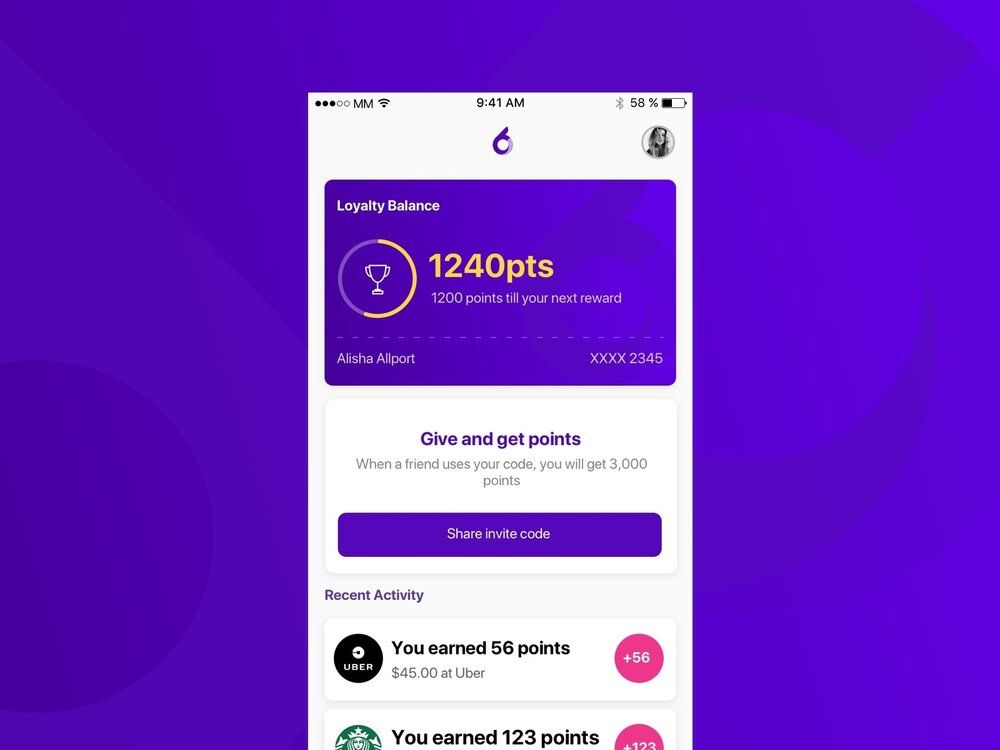
If you want to increase your retention rate, it might be a good idea to create a loyalty reward app for your rewards program (image by Alisha Allport)
First and foremost, with users having mobile devices on them for most of the day, you can improve visual recognition of your brand through the app’s icon, notifications, etc. This way, customers will be more likely to use a product they are already familiar with visually.
Moreover, loyalty programs are easy to personalize with the help of apps, which is one of the crucial factors for good retention rates.
It’s not only about using names instead of “You” or “Dear Customer” though. The main potential you can exploit here is tailoring your marketing campaigns, email and notification offers to each user’s needs:
- 91% of consumers would more likely opt for a brand that provides relevant recommendations and offers.
- 72% of customers ONLY engage with brands that offer personalization.
This clearly demonstrates that users mostly stay with brands that offer a personalized experience.
A loyalty program in an app makes it easier for you to access users’ personal data, track their behavioral patterns and interests. Thus, it gives you the necessary tools for making data-driven decisions and personalizing the program for each customer.
Additionally, mobile loyalty features encourage customers to engage with your brand for a longer time.
For instance, a user wants to check if they have any new coupons in your app. Since they’re already here, they might as well redeem their daily points for using the app; then, why not spin a wheel of fortune, too, since it doesn’t take much time.
Such dedication gives you more time to draw customers’ attention to your new events or discounts — whatever you need.
Our Expertise: Track Holodomor History
Recently, we developed an App for the National Holodomor Museum in Ukraine. It allows users to learn about historic locations all over Kyiv with archival data — photos, videos, documents, etc.
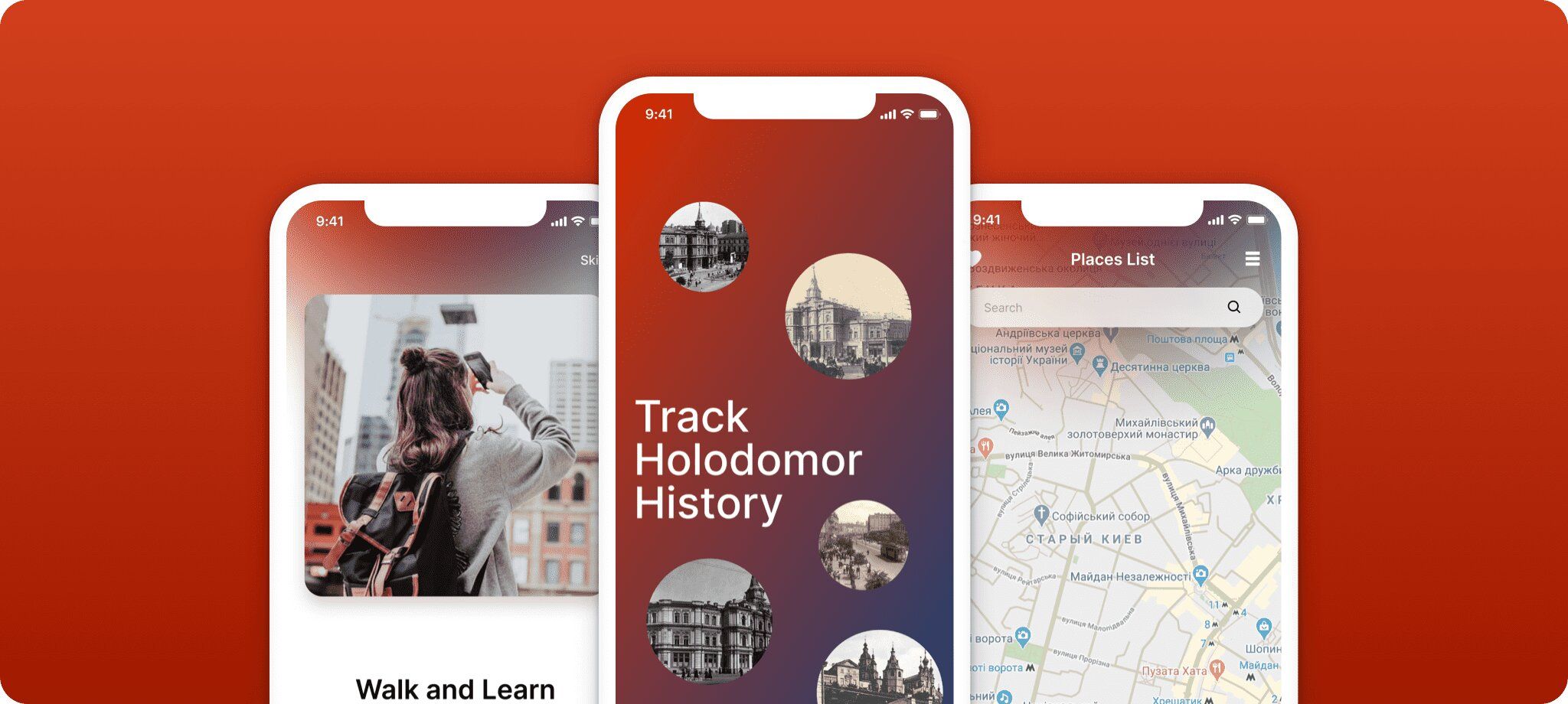
Such an app helped the National Holodomor Museum to improve digital loyalty (image by Stormotion)
One of their objectives was to establish loyalty among the existing audience and increase retention by providing visitors with digital content based on their GPS-Location. Here you can check our case study:
Customers’ Data Insights 📲
A mobile app is your key to useful customer information. Later on you can use it for marketing purposes and address your target audience more consciously.
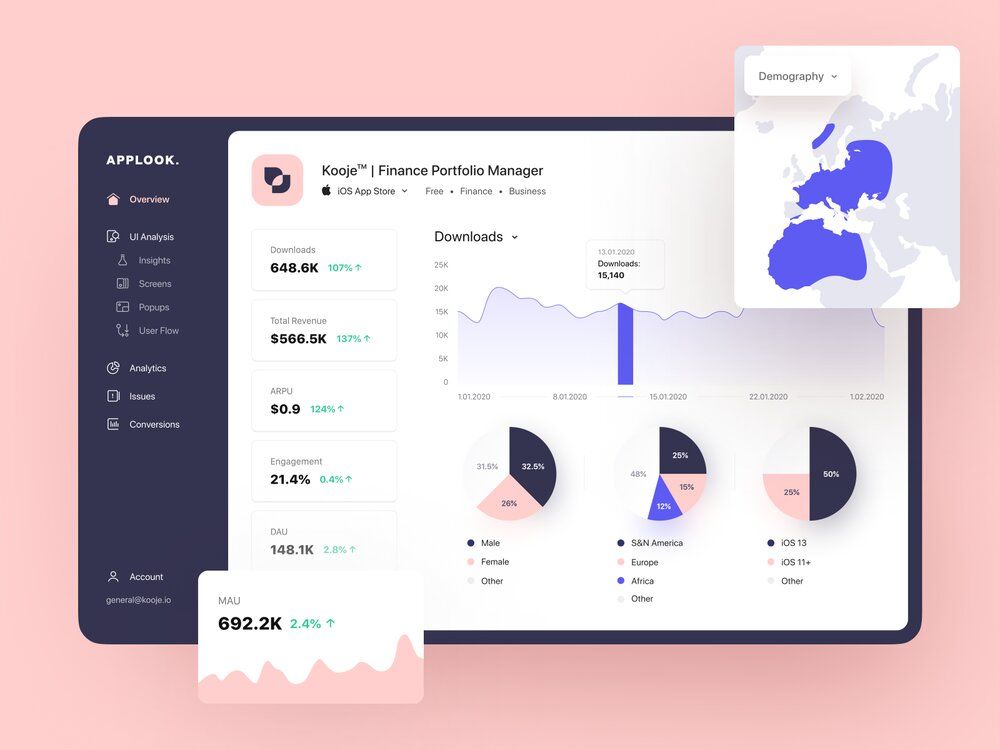
If you want to get more detailed info about your loyal customers, it might be a good idea to develop a loyalty app for your rewards program (image by Alexander Plyuto 🎲)
With an app, you can get to know your customers’:
- Age.
- Sex/gender.
- Location.
- Interests.
- Family, etc.
Surely, you can ask customers to fill in their profile with all this needed information. However, you can also just offer them to connect their Social Media like Facebook, Linkedin, Instagram, etc. (something that you know might have the details you want). It might be a good idea to offer a reward for the Social Sign Up.
Google Pay & Apple Wallet Integrations 💼
If you have a loyalty app that was developed with the help of app builders, it’s likely that you can’t implement any third-party services into it. However, some of them might be extremely beneficial for your business.
In this section, we’ll take a look at the integrations of Google Pay & Apple Wallet.
To get the most out of these features, you’ll need to have loyalty cards. So, if you’re not planning on getting such and/or not interested in this at all, feel free to go to the next section.
Google Pay Passes, Loyalty Programs & Offers
Google offers companies to integrate their loyalty program solutions with their API for:
- Automatic enrollment across devices, which helps to prevent certain troubles such as forgotten passwords (for users) or missed potential conversions due to the sign-in process.
- Personalized offers. Users add your loyalty card to their e-Wallet and you can then analyze how they use it.
- A fully digital experience. All coupons, gifts, rewards, cards, etc., are issued, redeemed, and managed electronically.
To integrate Google Pay, you don’t need much:
- Check their API documentation section.
- Get API access.
- Integrate it for testing purposes.
- Go live.
If you’re looking for experienced developers to support you with Google Pay API integration — feel free to contact us!
Apple Wallet
Apple offers their customers a lot specifically for loyalty programs as well. For instance, you can use their Apple Wallet API for:
- Automatic loyalty card selection when customers pay at the checkout.
- Touch/Face ID card activation.
- Real-time updates and notifications.
- Offering enrollment into the loyalty program without having to download the app or give any details right after customers use Apple Pay.
You can learn more about Apple Wallet integration on their “Get Started” page. Also, we’re here to help you with Apple Wallet integration — just drop us a line.
Integration with your existing infrastructure 💻
Oftentimes, businesses want to integrate their loyalty apps with the digital infrastructure they already use. In that case, you most probably have to go for a custom option since out-of-the-box solutions rarely offer such an opportunity.

If you want to develop a loyalty app and integrate it with your current infrastructure, custom loyalty app development might be more suitable for you (image by sri)
Let’s say that you have a CRM with several customer lists that you want to share with the app. With a custom solution, you can embed the Admin Panel of your loyalty program into the CRM or set up data exchange between the Panel and the CRM.
🎁 Rewards & Loyalty Strategies
Basically, loyalty strategies are the heart of your app, as well as the main tool for improving customer engagement and retention rate. That includes multiple features that you can combine to find the best fit for your use case.
In this section, we’re going to review top strategies you can use and specific details that you might want to pay attention to when building a loyalty app.
# 1: Points 💯
A points system is one of the most widely-used reward strategies that are effective for improving loyalty & KPIs. You can give users points for a bunch of activities:
- Achievements.
- Purchasing your goods and/or services.
- Spending certain amounts of money.
- Inviting friends. You can go even further here and offer an X% of points that your invited friend will get if he or she actually joins.
- Being part of a loyalty program for a certain amount of time.
- Sharing on social media.
- Writing reviews, etc.
Additionally, points can be the basis of other features like rewards that clients can get by collecting points and then redeeming them.
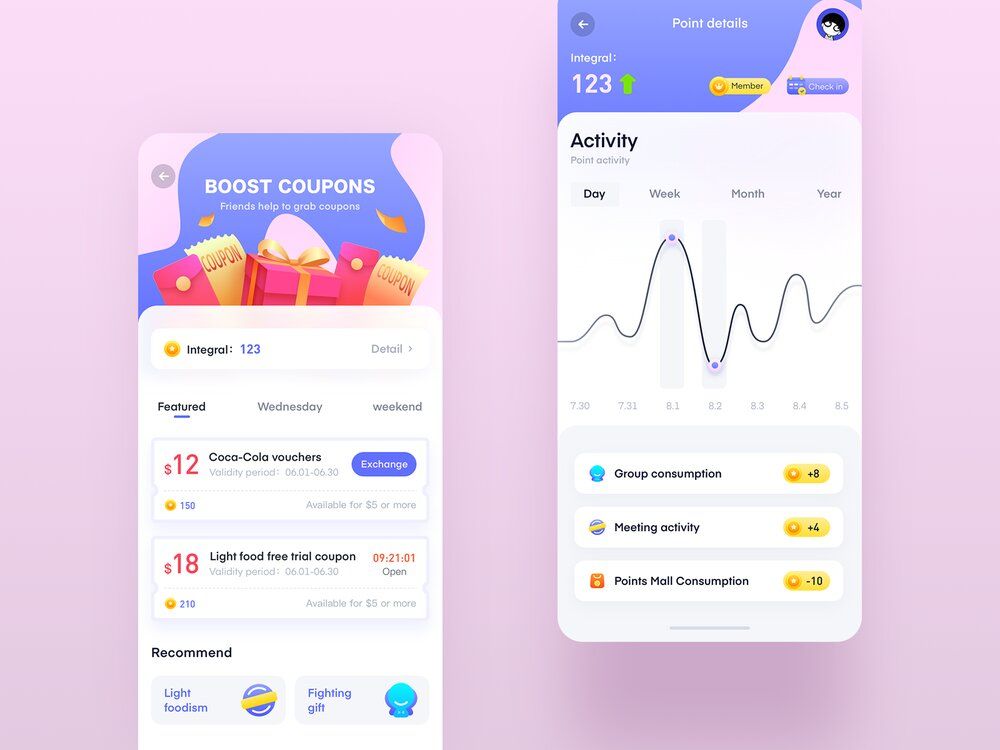
To develop a loyalty app, you can add a points system to encourage users to become loyal customers (image by [Muzi])
Customers can exchange their points for merchandise, any goods or services, discounts, coupons, etc.
To integrate a points system into your app, you can use different APIs like Rewards API from Amazon, have your own loyalty currency with Currency Alliance API, or any other API that is designed for such purposes.
# 2: Achievements & Rewards 🏆
This loyalty feature is one of the most beneficial ones for businesses since you can shape customer behavior with the help of it, meaning that by setting an achievement and offering a worthwhile reward for it, you are encouraging customers to complete it.
Achievements can include:
- Filling in an account.
- Social Media sign-in/email confirmation, which is a great way for you to access more detailed information about your customers for personalized marketing and better target audience understanding.
- Reaching certain targets/numbers of purchases.
- Inviting friends.
- Leaving feedback, etc.
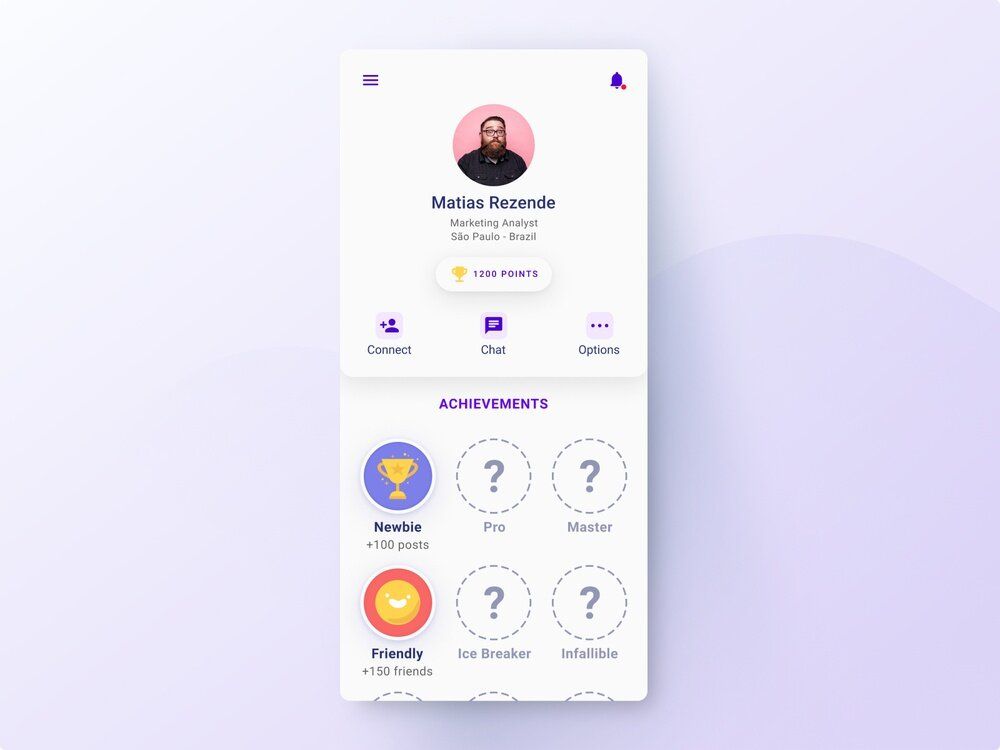
To build a loyalty app for small business or bigger companies, consider adding achievements to your rewards program (image by Caio Teixeira)
Make sure to rationally match the importance of achievements for you as a business with the rewards that customers get. For instance, “Buy 3 cups of coffee” might not be as beneficial as “Invite a friend,” meaning that the stimulus for the invitation of friends should be more significant.
You may notice that some achievements are similar to the actions we listed when talking about the points system. It’s because they’re connected — if a customer reaches a certain achievement, they get points.
However, achievements don’t and shouldn’t necessarily mean getting points. You can offer any rewards for completing them:
- Free goods/services or discounts.
- Merch.
- Limited features on your app like avatars, titles, badges, emojis, etc.
- Loyalty boosts (double points for a week, for instance), etc.
As we said, points, rewards, and achievements are closely connected. Thus, we recommend you to really think about how you’ll balance their interaction.
What we mean is that it might be a good idea to make certain rewards accessible by completing achievements only, while other ones will be received strictly for points, so users will pay attention to all of your loyalty features equally.
Monobank: Case Study |
|---|
Monobank is the first Ukrainian mobile-only bank that uses the financial infrastructure of Universal Bank. |
Also, we recommend offering some rewards for just being a part of your loyalty program and having the app installed. Thus, even if a user has low engagement with the features but is motivated enough not to delete your app, you can still send him or her personalized offers and try to retain them.
# 3: Stamps & Coupons 🎫
If you want to give users a convincing stimulus to get a specific product or service, or to make sure that they come back at least once, it might be a good idea to create a separate coupon screen where users will be able to manage this kind of loyalty campaigns.
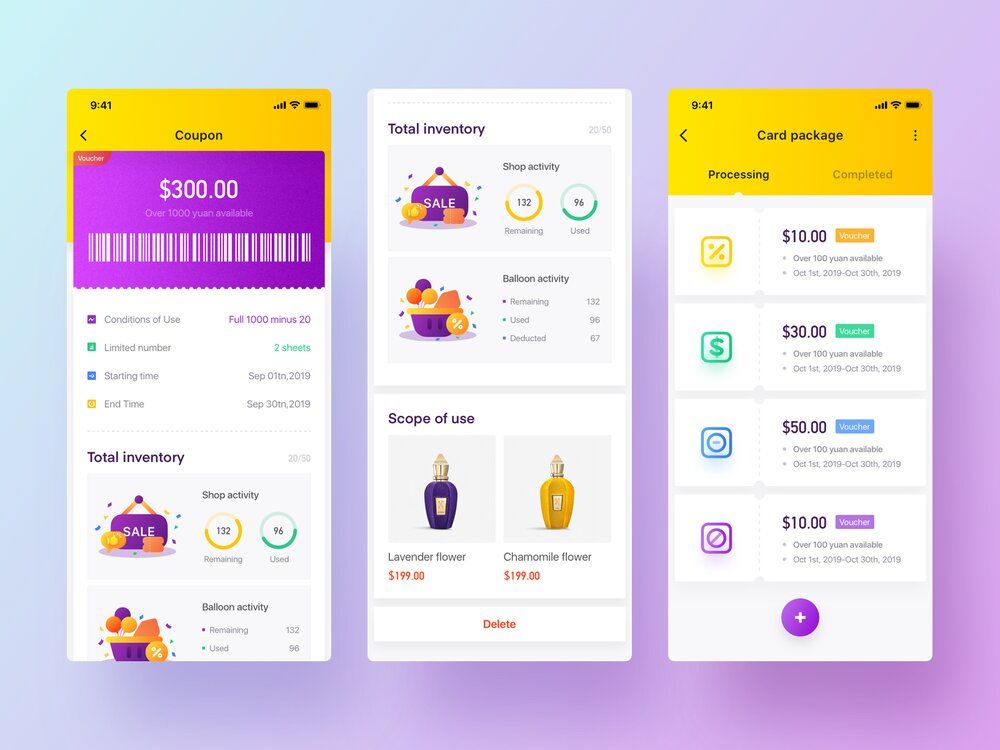
To build a mobile loyalty solution for small businesses or bigger corporations, think about adding coupons & gift cards to your rewards program (image by DorisPei)
This Screen can include:
- The list of available coupons.
- Additional information about the offer (if needed) and its expiration date.
- QR-code or just code for coupon redeeming.
- Marks for used/expired coupons. You can either recolor them (in gray) or remove them from the list completely.
Additionally, it can be beneficial for your business to have the so-called stamps system as part of your loyalty program users will get rewarded for a certain number of repeated actions.
McDonald's: Case Study |
|---|
Let’s take McDonald’s coupons as an example. The company has an app where users can get vouchers for different kinds of bonuses. For instance, a 25% discount for two cheeseburgers or a free coffee if you buy the Big Mac MacMenu. |
This one is also great for tailoring your customers’ behavior. For example, if an average check is $7-8, you can give a stamp for every $10 spent at once, which can encourage people to “invest” $2 more so as to eventually get a worthy reward.
To enable these features, you simply need to create digital coupons or stamps with your development team and designers.
# 4: Tiers 🥇
Creating tiers (levels, ranks — whatever you want to call it) for the loyalty app can help you improve the retention rate and build long-term relationships with your customers.

To create your own loyalty app, think about adding gift cards for higher tiers (image by Daniel Rasmussen)
You can offer better rewards and exclusive content for people at a higher rank, which is a great way to keep users engaged. Normally, mobile loyalty apps have the scale of a customer’s rank on the Home Screen — that strengthens the gamble of leveling up.
Thus, to level up, customers will need to reach a milestone. For example, you can gradually guide your customers from a 3% to a 10% discount with milestones at 5% and 7%. This is a win-win situation.
Marriott Hotels: Case Study |
|---|
A great example of such a “tiering” system is the worldwide network of hotels and resorts Marriott. |
For greater user engagement, you might give rewards for upgrading the tier. It can be anything from points to coupons to unique in-app gifts (avatars, emojis, etc.).
In terms of the development process, your Tech Partners can most likely take that up; third-party providers or APIs are optional here.
# 5: Leaderboards 📄
Leaderboards are another great way to keep users engaged and create a feeling of “the need to be more loyal than others.”
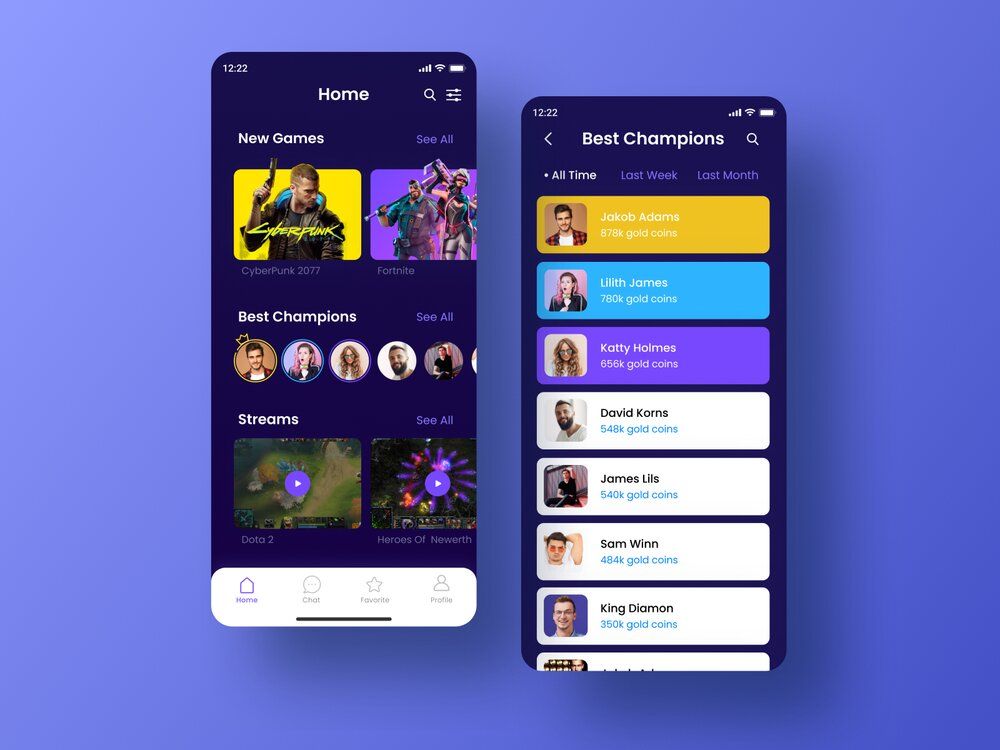
To boost customer loyalty, think about adding leaderboards (image by Anastasia Shalik)
Naturally, you can offer incentives and benefits for those who are at the top to keep customers motivated and engaged.
However, here’s the thing. It would be somewhat unfair if newbies landed on the same list as regulars who have been using your products/services for several months.
So, what we suggest you is to make several leaderboards for each separate group of customers based on the time they joined your app. For example, that’s what the different leaderboards can be:
- 1-3 weeks.
- 4-6.
- 7-9 and so on.
This way, you can create a never-ending flow of customers on the leaderboard with a more or less fair system of evaluation. Surely, those who are on the 3rd week of their journey with your company still have higher chances of being at the top compared to those who joined a couple of days ago, but isn’t that the point?
# 6: Digital Loyalty Cards 💳
If you want your customers to be able to have financial interactions with your app (like having a loyalty currency or adding banking cards to the in-app wallet) or enable FinTech features, you might need to use BaaS providers’ services.
These are companies with a ready-to-use financial infrastructure that you can implement into your app or website with their APIs without having to set up your own.
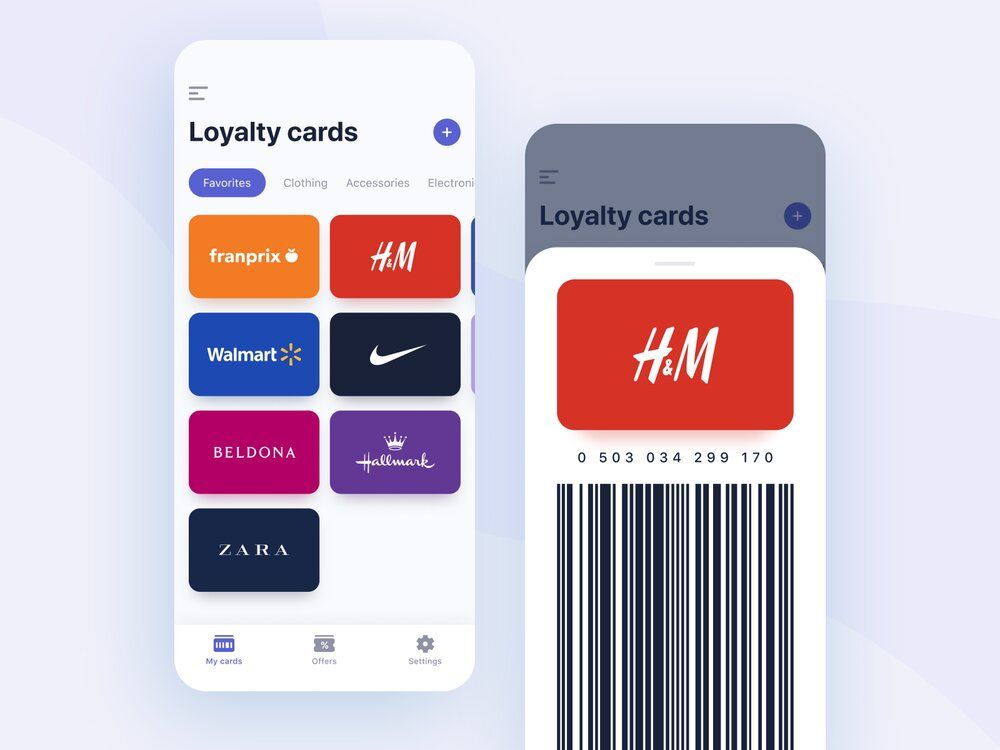
To boost customer loyalty, you can offer users digital loyalty cards (image by Fёdor Drobov)
You can offer:
- Digital loyalty cards. With this feature, users will be able to easily access their discounts, get points for purchases, or even use your in-app currency (points) to pay.
- An in-app wallet where customers can attach their debit, credit, and/or loyalty cards.
- Cash-back.
- The ability to see one’s purchase history.
- NFC tags.
- QR-code payments, etc.
Actually, we have an article dedicated to choosing a BaaS provider for your use case, so if you feel like it might come in handy, here’s the link:
# 7: Extra Strategies ✅
In this subsection, we’ll review some additional features that you might want to add for a better customer experience, however, they’re not as widely used as other ones.
# 1: Purchase History
This feature is intended to make future purchases a lot easier for customers. So, the next time a client is on your app, the goods or services that they bought last time or purchase regularly will pop up on their Home Screen.
Furthermore, it might be a good idea to allow them to save items as “Favorites” or choose permanent preferences so the search engine doesn’t offer irrelevant products to them.
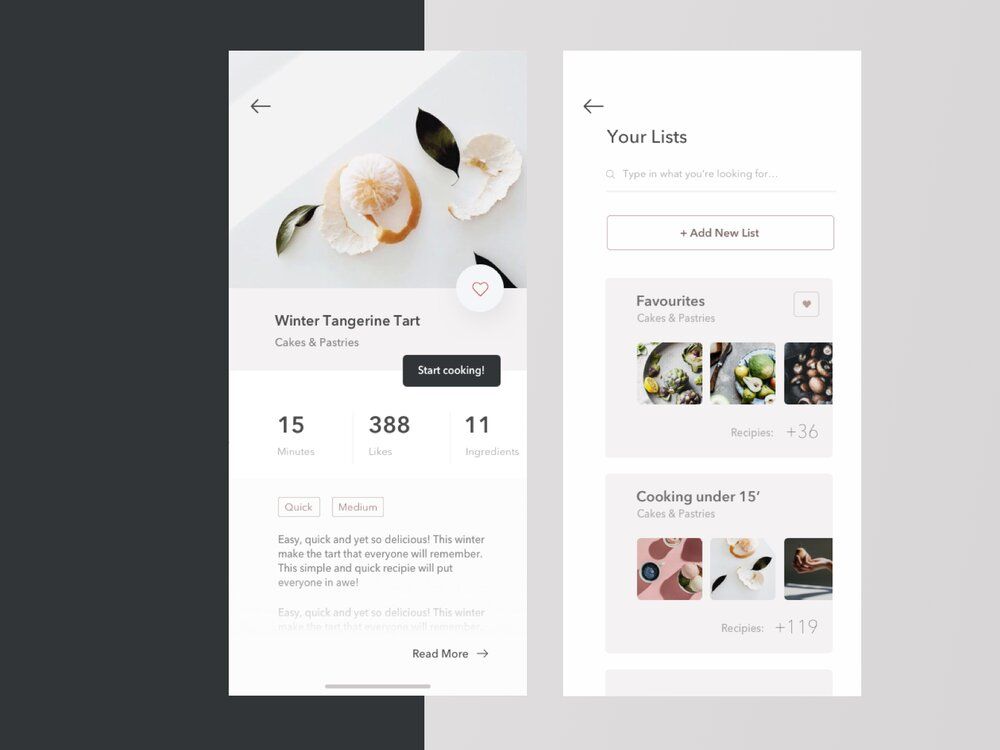
If you decide to enable additional features, don’t forget to include them to the costs of building a loyalty app (image by Julia Jakubiak)
Depending on the type of your product (selling goods or providing content, etc.), you might offer users to create their own lists with products for a more personalized experience.
# 2: Wheel of Fortune
You can set up a daily/weekly/etc. wheel of fortune to encourage users to visit the app on a regular basis.
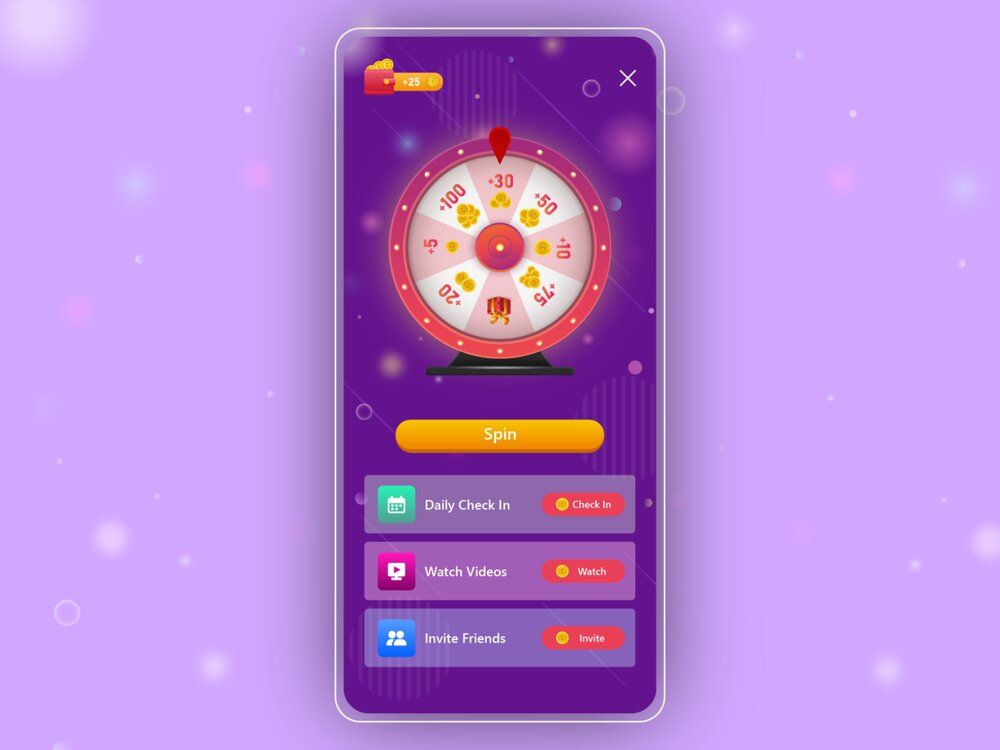
The wheel of fortune is a great, yet risky way to boost customer loyalty (image by Ali Nawaz)
It works really well on a psychological level since a good gamble thrills the human nervous system, which can help you retain customers and maybe even prevent them from stopping using the app.
Moreover, you can use this feature as an additional monetization model. Many businesses offer users to spin the wheel one more time for free if they watch an advertisement (that they’re paid to place there, obviously).
However, if you do decide to use this feature, make sure to find a balance so the app doesn’t turn into a playing field or is unprofitable because you give away too many rewards and discounts. Remember: the end goal is to improve brand loyalty, not to entertain customers at any cost.
# 3: Shake-to-Pay
If you have a brick-and-mortar place for users to come and purchase something, you might want to add such a technologically-advanced payment method as shake-to-pay.
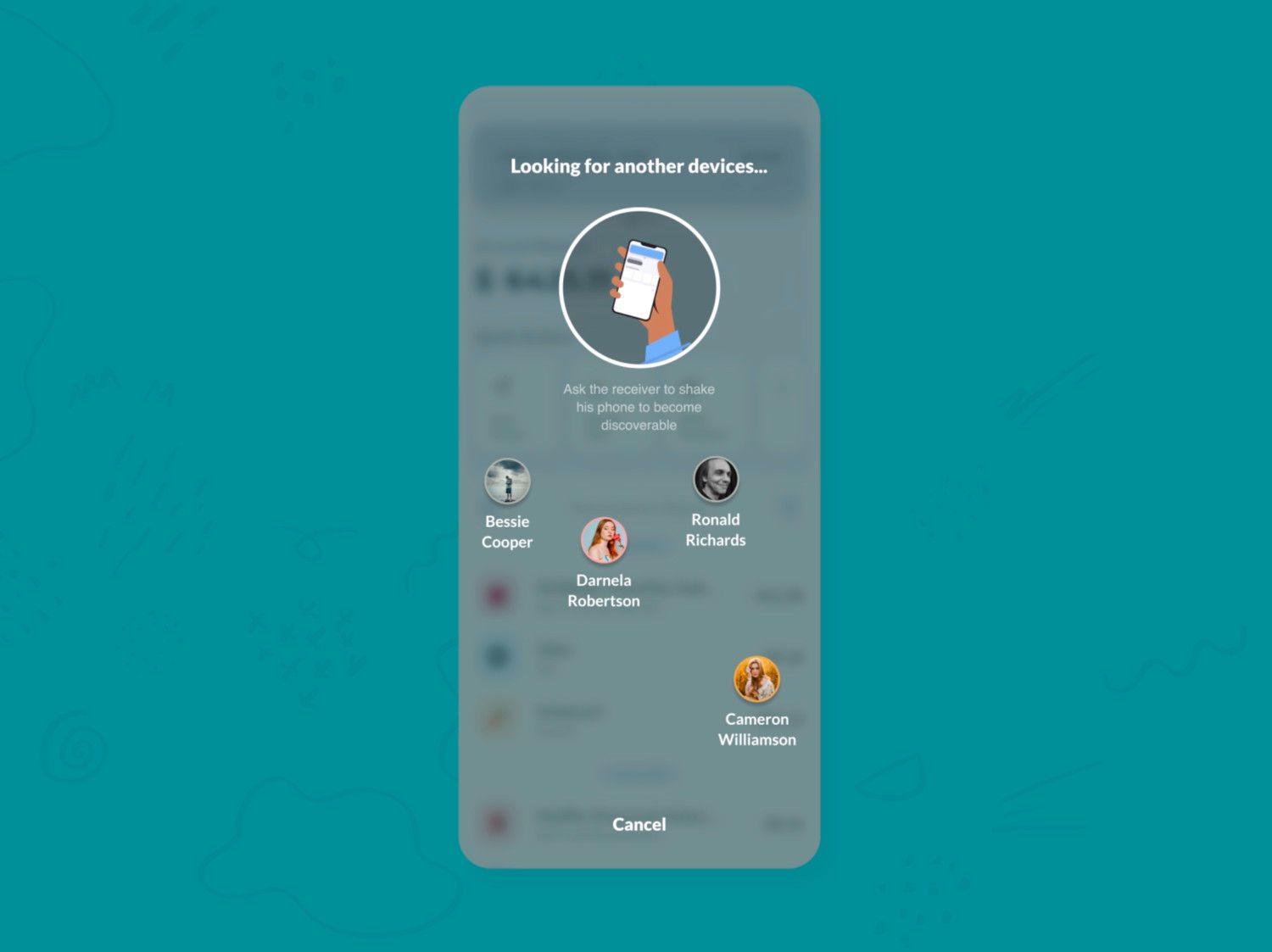
To be more high-tech, you can add such a feature during loyalty app development (image by Mark Altytsia: Product Designer 💻)
This feature can work in different ways. If we take Starbucks, they offer their customers to shake their device for the barcode of the Starbucks card to pop up.
Even though the feature is called Shake-to-Pay, the last component of this phrase can be functionally tailored to your use case.
📊 The Admin Panel for Loyalty Apps & Strategies
To be able to digitally manage the processes regarding your loyalty program and have an overview of the statistics, you’ll need some sort of a dashboard with access to all of the features.
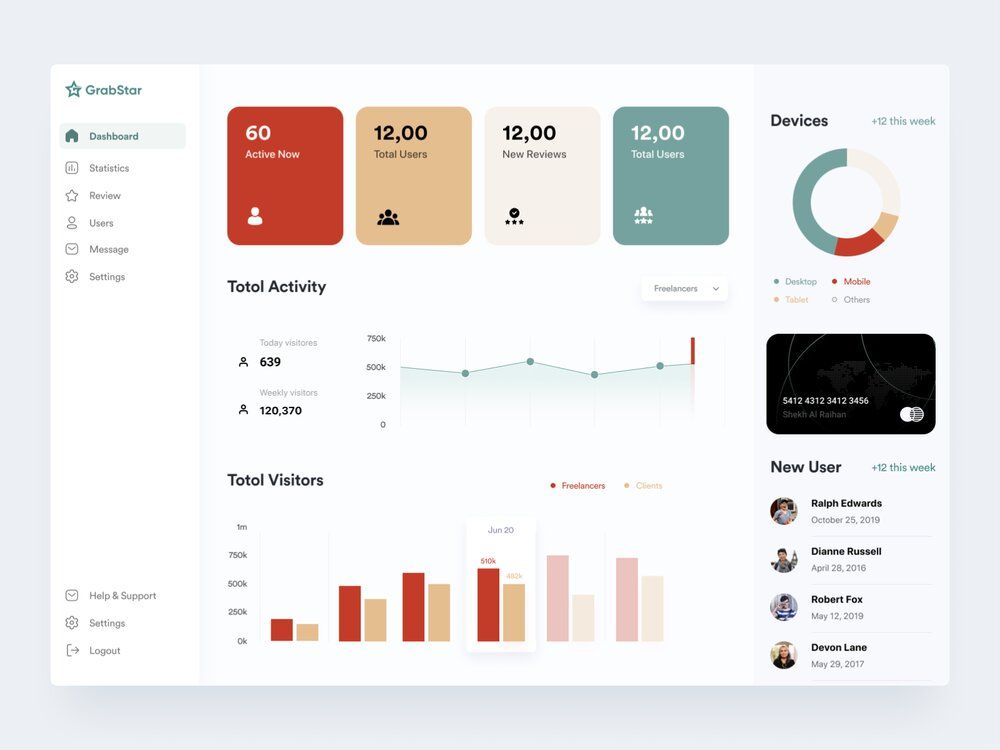
Loyalty app development can include building an admin panel as well (image by Shekh Al Raihan ✪)
This feature can include:
- The registration of new members.
- Access to and ability to change personal details. For instance, if you need to connect a user’s phone number to their account, it’s important to be able to do it manually from the admin panel. Especially, if you have physical branches.
- The management of events and campaigns.
- Updates and management of loyalty strategies.
Another essential part of this screen is analytics. It’s important to ensure that you can measure how successful (in all respects) your project is. This implies calculating: the total revenue, the revenue over a certain time span, the total number of users, the total number of new users and active users, the retention rate, the average time spent on the app, and other KPIs that are important to you.
🤖 The Tech Stack for Loyalty App Development
Even though most of the features can be built without using third-party APIs, there are many time-saving options on the market that you can implement into your custom loyalty app:
- Rewards API, Currency Alliance API for a points system.
- To enable rewarding, you can use RewardOps, Codemojo.
- For digital stamps and coupons, you can integrate Stripe, Coupons API from Paymentwall, MagicStamp.
- For digital loyalty cards or other FinTech services: SolarisBank, Railsbank, Marqeta, etc.
💰 What Affects Loyalty App Development Costs
It’s necessary to correctly calculate the cost of building a loyalty app to prevent troubles such as lack of financial means in the middle of the development. However, it’s quite hard to correctly predict the exact amount of costs since each case is unique.
However, there are a couple of factors that you should consider when planning the budget:
- Complexity, as well as the number of features.
- Chosen technology.
- Third-party integrations (if you need them).
- Hourly rate of your development team.
💡 Takeaways
A mobile app for your loyalty program is a great complement that can boost the benefits you get from having such a program.
In addition, it allows you to use more extended and digitally advanced loyalty strategies, access more detailed information about your members, and generally provide a better customer experience.
Furthermore, we’d like to give you 3 important recommendations for loyalty app development that we know from experience can be relevant for any type of business:
- Be user-friendly when it comes to your UI/UX design.
- Be consistent. Make sure that the app corresponds to the general mood and style of your brand.
- Be flexible. Try different kinds of loyalty programs, combine them to finally define what works best for your use case.
If you need any help with the development or have some questions left, feel free to contact us. We’ll find a way to help you!
Our clients say
![Stormotion client Alexander Wolff, CPO from [object Object]](/static/a16ba3c9580effc3ab9a68d115eadffe/b0e74/alex.png)
When I was working with Stormotion, I forgot they were an external agency. They put such effort into my product it might as well have been their own. I’ve never worked with such a client-focused company before.
Alexander Wolff, CPO
Sjut
Was it helpful?
Read also


